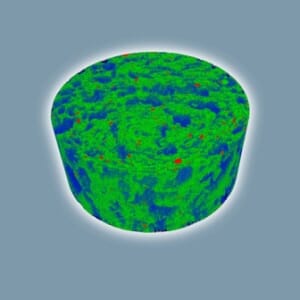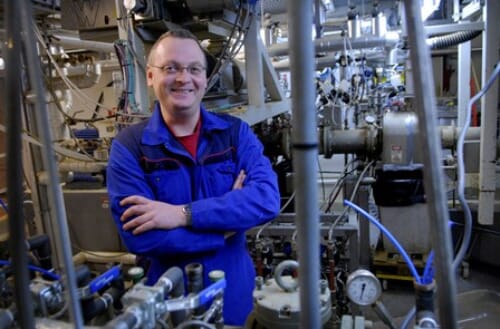Together with specialist software, these techniques are revealing the inner secrets of pore size and pellet structure and the ways in which minor ingredients can affect them.
 |
| X-rays to examine the fish feed pellet. |
Jan Jonkers is the Feed Production Manager at the Skretting Aquaculture Research Centre (ARC) in Stavanger, Norway. He gives an insight into the complicated world of fish feed pellets. Feed pellets for fish are far more complex to make than the compound feed pellets used in animal feeds. Reliable production of pellets with consistent nutritional and physical properties requires a thorough understanding of how the combination of ingredients will react at critical stages such as extrusion and coating. Vaporising the moisture content of the pellet at the moment of extrusion creates the initial porous structure but the pellet shrinks on drying. Getting the resulting porosity exactly right is a vital part of ensuring the final pellet will have the correct content of fats following the vacuum coating step. It influences the nutritional value of the pellet and its final density, which affects its floating or sinking behaviour. That is where the skill and knowledge of the process engineers are so important. In Skretting we hold monthly video meetings as a way of sharing the latest knowledge from ARC and the experience of our engineers around the world.
 |
| "Using specially developed software we are creating 3-D images of pellets, with colour to distinguish between oil and the matrix. You can actually achieve an effect of travelling through the pellet from end to end, says Jan Jonkers, the Feed Production Manager at Skretting ARC. |
These aspects are becoming more complex as fish feed companies identify and use a wider range of feed raw materials in their quest to control costs and to become more sustainable. While a Skretting feed will have consistent nutritional properties, the raw materials may vary from batch to batch, which affects the way the feed behaves in the production plant, says Mr Jonkers.
Other recent trends also have an impact. Increasingly Skretting is delivering feed from silo to silo, rather than in big bags. Transferring feed from the silo on the boat to a silo at the farms involves blowing it along pipes or using elevators and conveyors. Either way brings additional physical impacts on the pellets and we need to make them tougher. That is a challenge with feeds such as salmon grower feeds. The high contents of fats and proteins leave little space for the binding ingredients that hold the pellets together.
Skretting ARC is using the X-ray microtomography and NMR technology to investigate how different feed ingredients and variations in production parameters such as grinding influence the behaviour and structure of pellets in production and in use.
Examining pellets before and after coating, we see the internal structure, the size of the pores and variation in size. This is important as it affects physical properties and how the pellet behaves in vacuum coating. Using specially developed software we are creating 3-D images of pellets, with colour to distinguish between oil and the matrix. You can actually achieve an effect of travelling through the pellet from end to end.
Skrettings growing activities in shrimp feed brought another task for Mr Jonkers, In our feed pilot plant we are installing the equipment needed to manufacture shrimp feed, which has quite different physical requirements. For example it must sink quickly, to avoid floating away, and be very water stable with virtually no nutrient leakage as shrimp are slow eaters. When the equipment is in place we will explore different production techniques and raw materials, of course with X-rays and NMR providing those extra insights.

